On the afternoon of October 20, the Vietnamese stock market closed the trading session in a state of total panic. The selling pressure spread across all three exchanges, causing the VN-Index to drop 94.76 points, equivalent to 5.47%, to 1,636.43 points, the lowest level since the beginning of the third quarter. The HNX-Index also fell 13.09 points (-4.74%) to 263.02 points; while the UPCoM-Index lost 2.36 points (-2.09%) to 110.31 points.
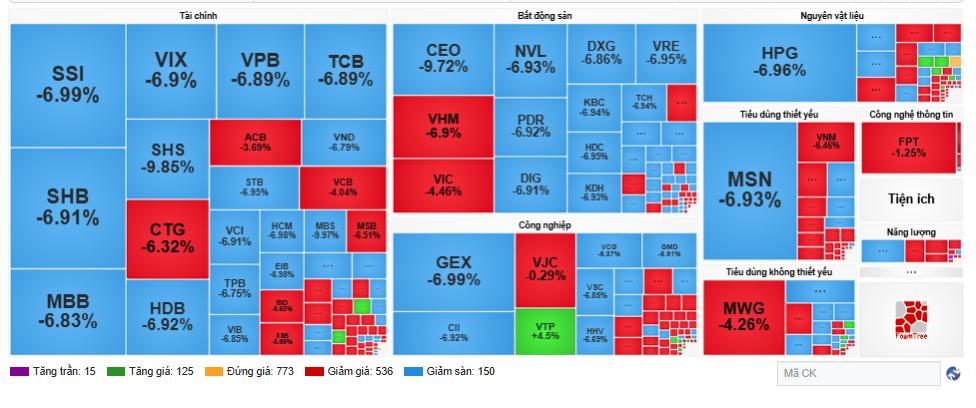
The total market trading value reached nearly 58,900 billion VND, the matched volume was over 1.96 billion shares, an unusually high level showing massive cash flow out of stocks. The market breadth was absolutely tilted towards the selling side with 150 stocks hitting the floor, with only less than 20 stocks increasing slightly.
According to analysts, this was a systematic sell-off (capitulation) session, when margin calls were triggered en masse. In the last 30 minutes of the ATC session, the market witnessed hundreds of stocks falling to the floor, many blue-chip stocks were sold off heavily regardless of price.
Securities companies were forced to liquidate to recover loans, while weak bottom-fishing demand caused prices to fall uncontrollably. The VN30 index, representing the largest capitalization stocks, lost more than 94 points, showing that liquidation pressure was mainly concentrated on blue-chip stocks, and was no longer a phenomenon in mid- and small-cap stocks.
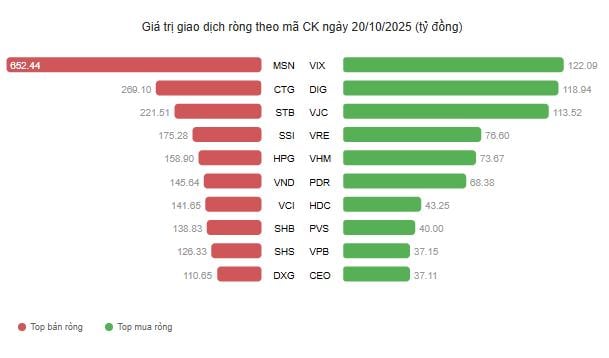
A leader of a securities company in Ho Chi Minh City commented: “When the leverage ratio in many accounts has reached the threshold of 50-60%, the sharp drop in prices will trigger a chain effect. Automatic liquidation orders will cause stock prices to fall rapidly, creating a spiral of panic.”
Most of the key sectors were in the red. Of which, banking and real estate were the two groups that suffered the most damage, causing the index to fall sharply. Specifically, in the banking group, there wereSHB (-6.9%), VPB (-6.89%), MBB (-6.83%), CTG (-6.32%), TCB (-6.89%). Real estate continued to be the "eye of the storm" with NVL (-6.93%), VHM (-4.46%), VRE (-6.95%), causing this group alone to take away an estimated 15 points from the VN-Index.
Securities groups were also sold off heavily, such as SSI (-6.99%), SHS (-9.85%), VIX (-6.9%), reflecting the direct risks from margin lending activities and investors' risk-avoidance psychology. Meanwhile, the information technology and essential consumer goods groups were less affected, with some codes such asFPT (-1.25%), VTP (+4.55%) still maintaining a certain demand.
Foreign investors net withdrew nearly 2,000 billion VND
According to statistics, foreign investors net sold up to 1,963.7 billion VND, the highest level since the beginning of the year. The selling volume was concentrated in large-cap stocks such as SSI, VND, VCI, VRE, HPG, contributing to increasing supply pressure. At the same time, the self-trading sector of securities companies also net sold more than 197 billion VND, mainly in MSN, STB, FPT, VNM, VIC, showing the trend of reducing portfolio risks of domestic organizations.
However, selective buying power from some foreign investment funds was still recorded in good fundamental codes such as VHM, VIC, DIG, DXG, MSN. According to analyst Le Minh Khoi (DNSE Research): "This reflects the differentiation of foreign capital flows. Some funds withdrew capital to hedge risks, while long-term investors took advantage of the opportunity to buy blue-chips at the bottom when the market was deeply discounted."
Investors believe that the crash on October 20 was not entirely unexpected. Previously, the VN-Index had repeatedly touched the resistance zone of 1,780 - 1,800 points, which is considered a short-term peak after a long-term uptrend. Profit-taking pressure increased, while new cash flow was not strong enough, making the market vulnerable to negative psychological shocks.
When the index fell sharply and broke through the support levels of 1,700, then 1,650 points, a series of automatic stop-loss orders and margin calls were triggered, creating a "sell-off storm". Liquidity suddenly increased to nearly 59,000 billion VND, 1.5 times the average of the last 10 sessions, proving widespread panic.
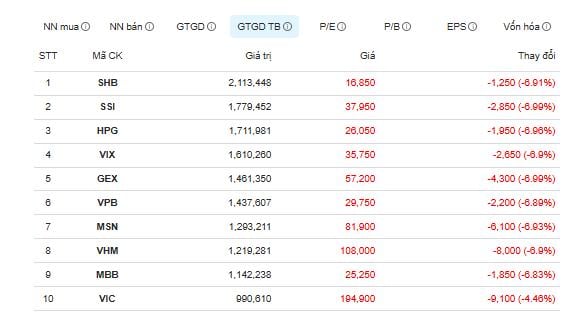
An expert from KBSV Securities Company commented: “The market is going through a “margin release” phase. When the margin lending rate is too high, a sharp price drop is inevitable for the system to rebalance itself. After sessions like this, the market usually needs a few accumulation sessions to absorb all the pressured supply.”
Technically, the VN-Index losing the strong support zone of 1,650 points has nullified the short-term recovery trend expected last week. According to analysis companies, if the index does not recover to the 1,650-1,670 point zone in the coming sessions, the possibility of re-establishing a new bottom around 1,580-1,600 points is very high.
Mr. Tran Quoc Binh, technical analyst at FiLi.vn, said: “This is a strong break in both price and psychology. A decrease of more than 5% in one session is rare in the Vietnamese market. However, the deep adjustment can make the price level more attractive for long-term cash flow.”
In the context of high risks, experts recommend investors to keep a large cash ratio, avoid using margin and wait for confirmation signals of institutional cash flow returning. For institutional investors, the current period may be the time to restructure portfolios, choose stocks with solid fundamentals, low debt and benefit from public investment policies.
Mr. Nguyen Duc Nam, an independent market expert, likened: “Investing in stocks is like gardening, requiring patience and discipline. After storms, the soil becomes more fertile. The problem is who has the courage to not be swept out of the market in a moment of panic.”
Although the sharp decline on October 20th caused heavy losses for many investors, experts said that this was also a necessary cleansing step. The market being forced down deeply helps reduce leverage, "cools" speculative cash flow, thereby creating a more stable foundation for the next growth cycle.
Positive macro signals such as controlled inflation, low interest rates, and sustained FDI inflows remain medium-term support factors for Vietnamese stocks. If foreign investors soon reduce net selling and self-employed investors return to net buying, the market could form a technical bottom in October before recovering slightly in early November.
Source: https://baotintuc.vn/thi-truong-tien-te/vnindex-mat-gan-95-diem-cu-soc-margin-chan-dong-toan-san-20251020153016326.htm




![[Photo] National Assembly Chairman Tran Thanh Man attends the VinFuture 2025 Award Ceremony](/_next/image?url=https%3A%2F%2Fvphoto.vietnam.vn%2Fthumb%2F1200x675%2Fvietnam%2Fresource%2FIMAGE%2F2025%2F12%2F05%2F1764951162416_2628509768338816493-6995-jpg.webp&w=3840&q=75)
![[Photo] 60th Anniversary of the Founding of the Vietnam Association of Photographic Artists](/_next/image?url=https%3A%2F%2Fvphoto.vietnam.vn%2Fthumb%2F1200x675%2Fvietnam%2Fresource%2FIMAGE%2F2025%2F12%2F05%2F1764935864512_a1-bnd-0841-9740-jpg.webp&w=3840&q=75)


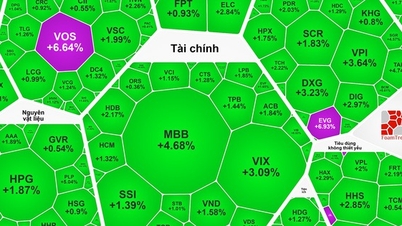

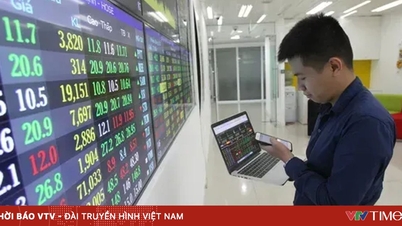















































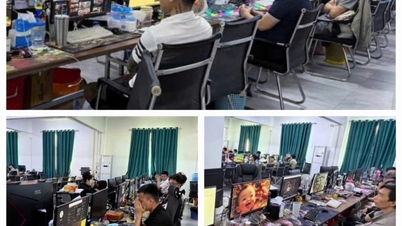






















































Comment (0)